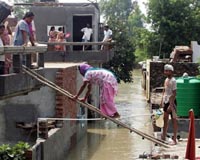| . |  |
. |
Paris (AFP) Aug 10, 2009 Children with seasonal flu should not be given Tamiflu because harmful side effects may outweigh relatively meagre benefits, according to a study released Monday. In some children Tamiflu caused nausea and vomiting, which can lead to dehydration and other complications, researchers reported. The study did not cover the current outbreak of swine flu, but it suggests that antivirals may not significantly reduce the length of illness or prevent complications in children infected with the new A(H1N1) virus, the researchers said. Carl Henegan, a doctor at John Radcliffe Hospital in Oxford and co-author of the study, said the current British practice of giving Tamiflu and Relenza -- the brand names for the antivirals oseltamivir and zanamivir -- for mild illness was "an inappropriate strategy." "The downside of the harms outweigh the one-day reduction in symptomatic benefits," he said. The research showed that both antivirals shortened the duration of seasonal flu by 12 to 36 hours. But the drugs had little or no effect on asthma flare-ups, increased ear infections or the need for antibiotics. In addition, Tamiflu was linked to an increased risk of vomiting. The study, published in the British Medical Journal (BMJ), comes 10 days after Britain's Health Protection Agency (HPA) reported that more than half of 248 students given Tamiflu after a classmate fell ill with swine flu suffered side-effects such as nausea, insomnia and nightmares. Most of the students did not have the flu when they were given the drug. Vaccines are the frontline defence against influenza, but in Britain and elsewhere antivirals are often prescribed -- for treatment and prevention -- when vaccines are in low supply or simply unavailable, as in the case of swine flu. The BMJ study, led by David Mant of Oxford University, concludes that a "more conservative strategy" in administering the drugs is probably in order. The researchers reviewed four earlier clinical trials -- two with Relenza and two with Tamiflu -- for influenza treatment covering 1,766 children 12 or younger. More half had confirmed cases of type A flu. They also reviewed three other trials in which the drugs were given to children who had been exposed to the virus but showed no symptoms. Such "proactive" use resulted in only an eight percent reduction in the incidence of influenza, though earlier studies have shown a higher rate of protection. None of the trials reviewed by the BMJ tested the efficacy of anti-virals against the new strain of swine flu that has swept across the globe since April, infecting hundreds of thousands and claiming more than 1,100 lives. Swiss pharmaceutical company Roche, the patent holder of Tamiflu, suggested that the symptoms described in the study might been due in part to the flu itself and not the medication. "According to the WHO, 50 percent of patients with the flu (swine or seasonal) have nausea symptoms or digestive problems caused by the illness," a Roche spokesman told AFP. "Clinical studies on children treated with Tamiflu have shown secondary effects such as nausea, but these have been moderate and it is extremely rare that treatment must be halted as a consequence," the spokesman said. Tamiflu is a so-called neuraminidase inhibitor that acts by blocking a viral enzyme that allows the flu virus to invade cells in the respiratory tract. The drug can be prescribed from the age of one year old. Severe symptoms in Japanese children taking Tamiflu reported earlier this decade -- delirium, hallucinations, encephalitis and 12 deaths -- were probably due to factors independent of the drug, according to several health authorities that investigated the cases, including the US Food and Drug Administration. Share This Article With Planet Earth
Related Links Epidemics on Earth - Bird Flu, HIV/AIDS, Ebola
 India swine flu death toll increases to six: officials
India swine flu death toll increases to six: officialsMumbai (AFP) Aug 10, 2009 The number of people to die from swine flu in India rose to six, health officials said Monday, as the government called for calm and people flocked to public hospitals for tests. The latest to die of the (A)H1N1 virus were an ayurvedic or traditional medicine practitioner in Pune, 120 kilometres (75 miles) from India's financial hub Mumbai, and a four-year-old boy in the southern city of Che ... read more |
|
| The content herein, unless otherwise known to be public domain, are Copyright 1995-2009 - SpaceDaily. AFP and UPI Wire Stories are copyright Agence France-Presse and United Press International. ESA Portal Reports are copyright European Space Agency. All NASA sourced material is public domain. Additional copyrights may apply in whole or part to other bona fide parties. Advertising does not imply endorsement,agreement or approval of any opinions, statements or information provided by SpaceDaily on any Web page published or hosted by SpaceDaily. Privacy Statement |